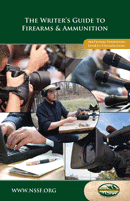Firearms Reference Resources
Posted: May 29, 2012
[caption id="attachment_10164" align="alignright" width="130"] image credit nssf.org[/caption]Old gun writers tend to be pedantic as they come, but at least there’s an underlying rationale in their fussiness. Aside from a professional's responsibility to get it right for the reader's sake, incorrect and imprecise language originating in media accounts have all too often fanned the flames of gun-control activism. Anti-gun politicians have been quick to seize on demonizing terminology like “assault rifles … high-capacity magazines … concealed weapons … cop-killer bullets” to name just a few.
image credit nssf.org[/caption]Old gun writers tend to be pedantic as they come, but at least there’s an underlying rationale in their fussiness. Aside from a professional's responsibility to get it right for the reader's sake, incorrect and imprecise language originating in media accounts have all too often fanned the flames of gun-control activism. Anti-gun politicians have been quick to seize on demonizing terminology like “assault rifles … high-capacity magazines … concealed weapons … cop-killer bullets” to name just a few.
[caption id="attachment_10164" align="alignright" width="130"] image credit nssf.org[/caption]Old gun writers tend to be pedantic as they come, but at least there’s an underlying rationale in their fussiness. Aside from a professional's responsibility to get it right for the reader's sake, incorrect and imprecise language originating in media accounts have all too often fanned the flames of gun-control activism. Anti-gun politicians have been quick to seize on demonizing terminology like “assault rifles … high-capacity magazines … concealed weapons … cop-killer bullets” to name just a few.
image credit nssf.org[/caption]Old gun writers tend to be pedantic as they come, but at least there’s an underlying rationale in their fussiness. Aside from a professional's responsibility to get it right for the reader's sake, incorrect and imprecise language originating in media accounts have all too often fanned the flames of gun-control activism. Anti-gun politicians have been quick to seize on demonizing terminology like “assault rifles … high-capacity magazines … concealed weapons … cop-killer bullets” to name just a few.
More often than not such objects are also described as “more powerful … deadlier … superior firepower.” The hyperbole comes from “mainstream” news outlets so often it makes you wonder if it’s not intentional, but that only makes it all the more important that legitimate outdoor communicators understand and accurately convey whatever it is they have to say about guns and shooting.
Recently I cringed at seeing one of the brightest new voices in outdoor media mention “steel bullets” and say that the .22-250 cartridge “travels at 4,000 feet per second, making it one of the most explosive out there … .” In the larger context these aren’t critical errors, but even minor misstatements can add to the public confusion cultured by the anti-gun side.
Because there’s a lot to learn about the arcane lexicon of firearms, most outdoor writers would benefit from consulting reference works. Here are a handful I recommend.
“The Writer’s Guide to Firearms and Ammunition” is available online at http://nssf.org/newsroom/writers/guide/). Produced by the National Shooting Sports Foundation specifically for professional journalists, this booklet offers discussions on fairness, statistical data and existing firearms law. It also offers a limited glossary.
NRA Firearms Sourcebook is offered for sale at http://www.nrastore.com/nrastore/ProductDetail.aspx?c=15&p=PB+01548&ct=e. A comprehensive (516-page) volume from NRA Publications, the Sourcebook deals largely with technical design, gunmaking and performance subjects, but also offers chapters on safety, firearm history, laws, gun collecting and more. It provides an extensive glossary, data fields and source listing of the firearms industry.
Hallowell’s Online Glossary -- http://www.hallowellco.com/abbrevia.htm. This lengthy stand-alone glossary also offers photo images of many entries. It is useful for anyone seeking clarification or more information about a known term.
Biz Tip Courtesy of John Zent, NRA Publications